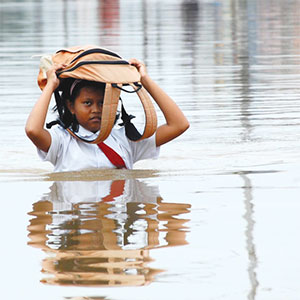Social vulnerability and other climate-related indices can be valuable tools for public health, but they should be used with caution in research, according to Ferdouz Cochran, Ph.D., a climate-health science lead at the Health Innovation Center at MITRE Labs.
“There are questions that we really need to think about before using these metrics because most indices are created for planning purposes and not necessarily for further research,” Cochran said during a Climate Change and Health Seminar Series presentation on June 7.

Cochran is a member of the inaugural class of the National Institutes of Health (NIH) Climate and Health Scholars, part of a cross-cutting effort to reduce health threats from climate change and build health resilience, especially among high-risk populations. Since February, Cochran has been working with the NIEHS Epidemiology Branch in the Chronic Disease Epidemiology Group to identify the challenges and opportunities for data integration in population studies.
A self-described integrated geographer, Cochran explained how she uses maps and metrics to look at the interaction between humans and the environment.
“My work explores how humans are impacting our climate and how in turn our climate impacts us, which is, of course, a way of describing the field of climate and health,” she said.
Mental models
Cochran’s research examines climate and health interactions across space and time using geospatial data. In 2020, she co-authored a study that showed living near nature could improve women’s self-reported general health.
“For me, a key takeaway from that study was that all epidemiological studies, if possible, should consider stratifying by climate regions and zones,” said Cochran. The data used were from the NIEHS Sister Study.
To address the challenges of integrating climate and health data, Cochran believes it is important to draw out a “mental model” of the research problem to think through the research questions or hypotheses. Cochran credits University of Washington professor Kristie Ebi, Ph.D., who recently met with the NIEHS Epidemiology Branch, with reminding her of this fundamental first step in climate health research. These mental models can help identify which types of data — which spatial and temporal scales, for example — are relevant.
“That can help us start to untangle those direct and indirect exposures and socioeconomic and other environmental data,” she explained.
No universal threshold
Cochran described the features and limitations of various types of data available for studying the impacts of floods and heat on human health.
“When it comes to floods, there really is not one product to recommend, and I believe we need more work across federal agencies and partners to create a more comprehensive go-to product for climate and health research,” she said.

Cochran also explained that the well-known heat index is often inadequate for protecting human health. After local health departments in New York City showed that more than 70% of heat-related deaths occurred below 95 degrees, they worked with the National Weather Service to lower the threshold for heat advisories to a forecast of 95 degrees or above for two consecutive hours rather than days.
“There are important methodological and data attributes that need to be considered in the linkage of historic climate and weather data to existing cohort studies,” said webinar host Kaitlyn Lawrence, Ph.D., staff scientist in the Chronic Disease Epidemiology Group. “These considerations are best facilitated through interdisciplinary collaboration.”
(Marla Broadfoot, Ph.D., is a contract writer for the NIEHS Office of Communications and Public Liaison.)









